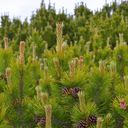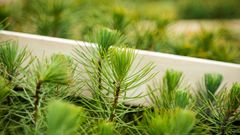

Native to Austria and the Balkans, the subspecies pinus nigra nigricans austriaca has been introduced to a large part of Europe and the U.S. It's a tree species cultivated for production.
This resistant, resinous species produces wood with good mechanical properties. It is particularly used for timber. As a species, it tolerates a variety of soil and helps reforest mountainous terrains. It's also an alternative species to spruce, which had been widely planted in eastern France and fell victim to a bark beetle epidemic. We'll use it in our reforestation of the Montplonne forest in France.
The Black Pine is an interesting tree that helps the environment by growing in areas after the first plants have settled. It loves sunlight and usually appears in plant communities after other trees have started to grow. In some cases, it can be the first tree to grow in an area. Even though it prefers light, young Black Pines can handle some shade.
This tree is tough and can survive in extreme conditions like cold, drought, and air pollution. It grows well on dry, chalky, and clay soils, even if the soil is compact, because of its strong roots that can grow in shallow ground.
Black Pine is well-suited to grow in shady oak and warm beech forests. It can also be planted in areas with Holm oak, but it can be attacked by certain caterpillars.
This tree is often used to reforest dry, rocky areas, especially in northeastern France. It has played a big role in restoring mountain areas like the Southern Alps, where it grows alongside trees like Downy Oak, Scots Pine, and Beech.
Austrian pine produces a softwood with good mechanical properties. It can be used for carpentry and lumber. It is a good wood for making paper pulp. It is prone to the production of abundant knots, but good silviculture can reduce the extent of these.
The name of the pine comes from the Celtic "pen," which means "the head, the top, the point." This tree symbolises an awakening, the consciousness of being. In the Far East, the pine is also a symbol of immortality.
Our goal is to enable anyone to do something that benefits nature and helps us to live in a more harmonious world. So why not become a tree owner in a European forest and help combat climate change?






Please note that this is promotional communication. See our notice of information.